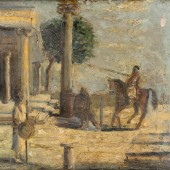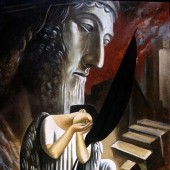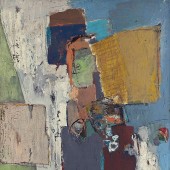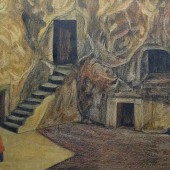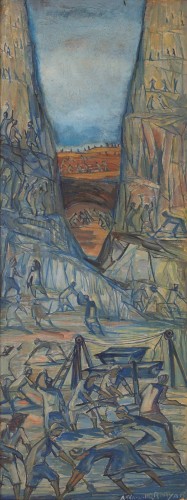
Ragheb Ayad’s painting of the Aswan Dam, like that of Effat Naghi’s painting of the same theme, are part of the Egyptian government’s art commissions program in the late 1950s to 1960s to depict the massive construction project of the Aswan Dam. In this painting, Ayad has narrowed the frame to compress the sense of height of the engineering project and its scaffolding. He also deliberately focused on the teams of heavy manual labour used in removing earth and block elements with hand carts, picks or shovels. The absence of massive construction machinery shifts the emphasis here to Egyptian workers in a manner that connects it with the building of monuments throughout history and into antiquity. In creating a pierced triangular framing through the rising scaffolds besides the cliff passageway, he highlights the tenuously chiseled paths along narrow cliffs.
Numerous other artists and writers, including the Egyptian novelist, Sonallah Ibrahim, were hired as artists, photographers and journalists to cover the building of the dam. Ibrahim later rewrote this experience as a novel, The Star of August, on the dangers facing those left at the bottom of the scaffolding. Ayad was among the first class of students to enter in 1908 and graduate in 1911 from the new School of Fine Arts in Cairo. In 1928, he received a Diploma from the Royal Academy of Fine Arts in Rome and returned to Egypt where he held appointments at the School of Applied Art in Giza and at the School of Fine Arts in Cairo.
تمثل لوحة راغب عياد لسد أسوان، وهو الموضوع ذاته الذي تناولته عفت ناجي في لوحتها، جزءاً من برنامج اللجان الفنية التي شكلتها الحكومة المصرية منذ أواخر الخمسينيات وحتى الستينيات لتوثيق مشروع بناء السد الضخم في أسوان. وقام عياد في هذه اللوحة بتضييق الإطار لتعزيز إحساس المشاهد بمدى ارتفاع المشروع الهندسي والسقالات المستخدمة فيه. كما تعمد التركيز على فرق العمل اليدوي المُجهد الذين يزيلون الركام باستخدام العربات اليدوية أو المعاول أو المجارف. فمع غياب آلات البناء الضخمة، تحول التركيز في اللوحة إلى العمال المصريين بأسلوب يستحضر بناء المعالم الأثرية عبر التاريخ وفي العصور القديمة. وبإنشاء منظور ثلاثي من خلال السقالات المتصاعدة على جانب الجرف المنحدر، يسلط عياد الضوء على الممرات المنحوتة على طول المنحدرات الضيقة.
وتم توظيف العديد من الفنانين والكتاب، مثل الروائي المصري صنع الله إبراهيم، والفنانين والمصورين والصحفيين لتغطية عمليات بناء السد. وقد أعاد الروائي إبراهيم كتابة هذه التجربة في روايته “نجمة أغسطس”، والتي سلطت الضوء على المخاطر التي واجهها العمال الذين كانوا يعملون أسفل السقالات. ويعتبر عياد من الطلاب الأوائل الذين التحقوا بمدرسة الفنون الجميلة بالقاهرة في عام 1908 وتخرج منها عام 1911. وفي عام 1928، حصل عياد على شهادة الدبلوم من الأكاديمية الملكية للفنون الجميلة في روما وعاد بعدها إلى مصر، حيث شغل عدة مناصب في مدرسة الفنون التطبيقية في الجيزة، ومدرسة الفنون الجميلة بالقاهرة.




